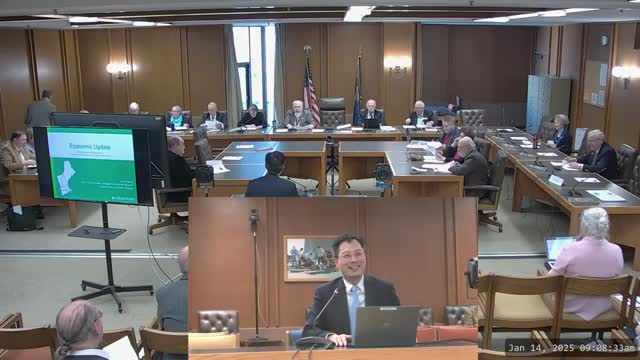Federal Home Loan Bank economist: inflation near target but services and housing keep pressure on prices
January 14, 2025 | Ways and Means, House of Representatives, Committees , Legislative, New Hampshire
This article was created by AI summarizing key points discussed. AI makes mistakes, so for full details and context, please refer to the video of the full meeting. Please report any errors so we can fix them. Report an error »

Jason Wong, senior vice president of strategic planning and research at the Federal Home Loan Bank of Boston, told the Ways and Means briefing that U.S. inflation has moved from the highs of 2022 to “between 2% and 3%,” close to the Federal Reserve’s 2% target. He said the decline is largely the result of easing price pressure for goods after pandemic-era supply-chain disruptions, while inflation in services — especially rent and other housing costs — remains elevated.
Wong said the Fed focuses on the PCE (personal consumption expenditures) index; “the most recent reading of that was 2.4%,” he said. He noted core PCE, which strips volatile food and energy, is slightly higher and that “the core index is still coming in a little bit closer to 3 than it is to 2.”
Why it matters: Wong framed the issue as a two-part story. Price pressure on goods has largely passed as supply‑chain stress eased (he cited the New York Fed’s Global Supply Chain Pressure Index). By contrast, services account for about two‑thirds of household spending and show persistent inflation driven in large part by housing and by wage costs embedded in service industries.
Wong described durable‑goods prices — used and new cars, appliances — as now easing or falling year‑over‑year, reversing the pandemic spike. “Used car prices have been declining over the past year,” he said, while rent and ‘shelter’ measures remain the largest contributor to persistent inflation. He pointed to market‑based rent trackers such as Zillow that show rents peaking in early 2022 and declining toward a plateau near 4% year‑over‑year in late 2024; CPI shelter measures, however, lag those market indicators.
On labor markets he said levels look strong — New Hampshire and Vermont had very low unemployment in recent data — but trends are important. He highlighted job‑postings indexes that fell from 2022 peaks and noted declines in the quit rate as a concern, because fewer voluntary separations can signal a cooling labor market and fewer opportunities for wage‑led reallocation.
Wong’s assessment of the outlook: he described the consensus view among forecasters as a possible “soft landing” — inflation easing to around the Fed’s target while unemployment remains modest — but he emphasized uncertainty. He listed risks that could push inflation or hurt activity, including energy‑price moves, tariffs or trade shocks, and unexpectedly persistent service‑sector wage growth.
What he did not say: Wong did not advocate for specific state fiscal measures. His presentation focused on national and regional data and on the likely drivers the Federal Reserve will weigh when setting monetary policy.
Ending: Wong told committee members he would provide slide materials and said his overall takeaway was that the U.S. has made substantial progress on inflation but remains “in the last mile,” with housing and services the primary challenge going forward.
Wong said the Fed focuses on the PCE (personal consumption expenditures) index; “the most recent reading of that was 2.4%,” he said. He noted core PCE, which strips volatile food and energy, is slightly higher and that “the core index is still coming in a little bit closer to 3 than it is to 2.”
Why it matters: Wong framed the issue as a two-part story. Price pressure on goods has largely passed as supply‑chain stress eased (he cited the New York Fed’s Global Supply Chain Pressure Index). By contrast, services account for about two‑thirds of household spending and show persistent inflation driven in large part by housing and by wage costs embedded in service industries.
Wong described durable‑goods prices — used and new cars, appliances — as now easing or falling year‑over‑year, reversing the pandemic spike. “Used car prices have been declining over the past year,” he said, while rent and ‘shelter’ measures remain the largest contributor to persistent inflation. He pointed to market‑based rent trackers such as Zillow that show rents peaking in early 2022 and declining toward a plateau near 4% year‑over‑year in late 2024; CPI shelter measures, however, lag those market indicators.
On labor markets he said levels look strong — New Hampshire and Vermont had very low unemployment in recent data — but trends are important. He highlighted job‑postings indexes that fell from 2022 peaks and noted declines in the quit rate as a concern, because fewer voluntary separations can signal a cooling labor market and fewer opportunities for wage‑led reallocation.
Wong’s assessment of the outlook: he described the consensus view among forecasters as a possible “soft landing” — inflation easing to around the Fed’s target while unemployment remains modest — but he emphasized uncertainty. He listed risks that could push inflation or hurt activity, including energy‑price moves, tariffs or trade shocks, and unexpectedly persistent service‑sector wage growth.
What he did not say: Wong did not advocate for specific state fiscal measures. His presentation focused on national and regional data and on the likely drivers the Federal Reserve will weigh when setting monetary policy.
Ending: Wong told committee members he would provide slide materials and said his overall takeaway was that the U.S. has made substantial progress on inflation but remains “in the last mile,” with housing and services the primary challenge going forward.
View full meeting
This article is based on a recent meeting—watch the full video and explore the complete transcript for deeper insights into the discussion.
View full meeting
